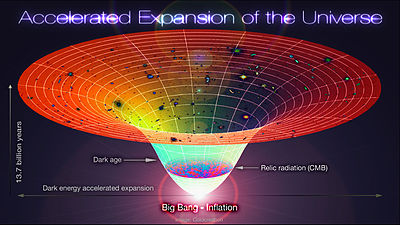
Back تسارع توسع الكون Arabic ক্রমপ্রসারমাণ মহাবিশ্ব Bengali/Bangla Expansió accelerada de l'Univers Catalan Zrychlování rozpínání vesmíru Czech Universo en akcelo EO Expansión acelerada del universo Spanish Universumi kiirendatud paisumine ET Azeleratutako unibertsoa EU انبساط شتابدار جهان FA Maailmankaikkeuden kiihtyvä laajeneminen Finnish
| Part of a series on |
| Physical cosmology |
|---|
 |

Observations show that the expansion of the universe is accelerating, such that the velocity at which a distant galaxy recedes from the observer is continuously increasing with time.[1][2][3] The accelerated expansion of the universe was discovered in 1998 by two independent projects, the Supernova Cosmology Project and the High-Z Supernova Search Team, which used distant type Ia supernovae to measure the acceleration.[4][5][6] The idea was that as type Ia supernovae have almost the same intrinsic brightness (a standard candle), and since objects that are further away appear dimmer, the observed brightness of these supernovae can be used to measure the distance to them. The distance can then be compared to the supernovae's cosmological redshift, which measures how much the universe has expanded since the supernova occurred; the Hubble law established that the further away an object is, the faster it is receding. The unexpected result was that objects in the universe are moving away from one another at an accelerating rate. Cosmologists at the time expected that recession velocity would always be decelerating, due to the gravitational attraction of the matter in the universe. Three members of these two groups have subsequently been awarded Nobel Prizes for their discovery.[7] Confirmatory evidence has been found in baryon acoustic oscillations, and in analyses of the clustering of galaxies.
The accelerated expansion of the universe is thought to have begun since the universe entered its dark-energy-dominated era roughly 5 billion years ago.[8][notes 1] Within the framework of general relativity, an accelerated expansion can be accounted for by a positive value of the cosmological constant Λ, equivalent to the presence of a positive vacuum energy, dubbed "dark energy". While there are alternative possible explanations, the description assuming dark energy (positive Λ) is used in the standard model of cosmology, which also includes cold dark matter (CDM) and is known as the Lambda-CDM model.
- ^ Overbye, Dennis (20 February 2017). "Cosmos Controversy: The Universe Is Expanding, but How Fast?". The New York Times. Retrieved 21 February 2017.
- ^ Scharping, Nathaniel (18 October 2017). "Gravitational Waves Show How Fast The Universe is Expanding". Astronomy. Retrieved 18 October 2017.
- ^ Weaver, Donna; Villard, Ray (11 March 2018). "Measuring universe expansion reveals mystery – Is something unpredicted going on in the depths of space?". Earth & Sky. Retrieved 11 March 2018.
- ^ "Nobel physics prize honours accelerating universe find". BBC News. 2011-10-04.
- ^ "The Nobel Prize in Physics 2011". Nobelprize.org. Retrieved 2011-10-06.
- ^ Peebles, P. J. E.; Ratra, Bharat (2003). "The cosmological constant and dark energy". Reviews of Modern Physics. 75 (2): 559–606. arXiv:astro-ph/0207347. Bibcode:2003RvMP...75..559P. doi:10.1103/RevModPhys.75.559. S2CID 118961123.
- ^ Weinberg, Steven (2008). Cosmology. Oxford University Press. ISBN 9780198526827.
- ^ a b Frieman, Joshua A.; Turner, Michael S.; Huterer, Dragan (2008). "Dark Energy and the Accelerating Universe". Annual Review of Astronomy and Astrophysics. 46 (1): 385–432. arXiv:0803.0982. Bibcode:2008ARA&A..46..385F. doi:10.1146/annurev.astro.46.060407.145243. S2CID 15117520.
Cite error: There are <ref group=notes> tags on this page, but the references will not show without a {{reflist|group=notes}} template (see the help page).